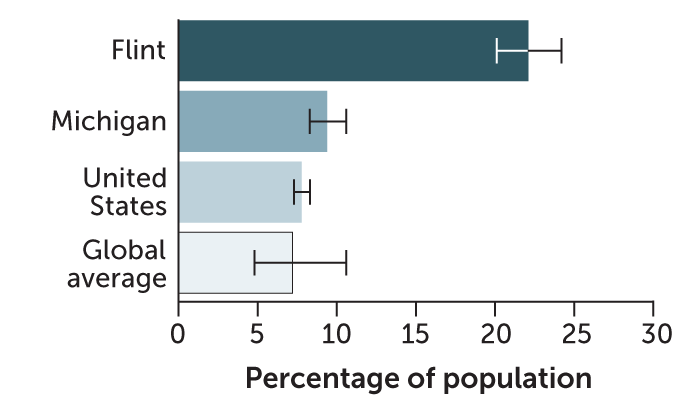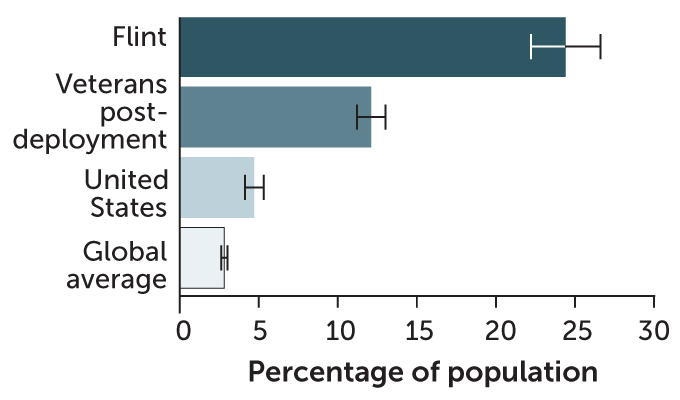Flint grapples with the mental health fallout from the water disaster
The community is still healing from the crisis that started almost a decade ago

At Flint City Hall in 2015, residents call for access to clean water.
Christian Randolph/The Flint Journal-MLive.com/Associated Press
On a Saturday in May in Flint, Mich., residents took seats in one of three rings of chairs at a local food bank. The 50 or so participants, spanning three generations, would spend time that morning sharing stories and practicing deep listening as part of a healing circle. It’s one component of a wider community-based movement to build relationships and challenge racist beliefs and systems.
In one circle, healing practitioner Todd Womack asked participants to introduce themselves and describe their favorite desserts. Fingers snapped softly to signal mutual enjoyment. Next, participants paired off, with instructions to take turns asking about something that recently made them smile or laugh — and to listen without interruption. From there, new pairs moved to other topics, such as an accomplishment they were proud of.
Healing circles are a space to foster community, says Lynn Williams, the director of equity and community engagement at the Community Foundation of Greater Flint, who helped organize the event that morning. The circles allow room for “healing of trauma from systems, from oppression, from negativity,” she says. And they provide a place to tell a community’s full story, to “highlight the assets and the cultural contributions.”
The circles are one way to let people know they matter when society keeps telling them they don’t.
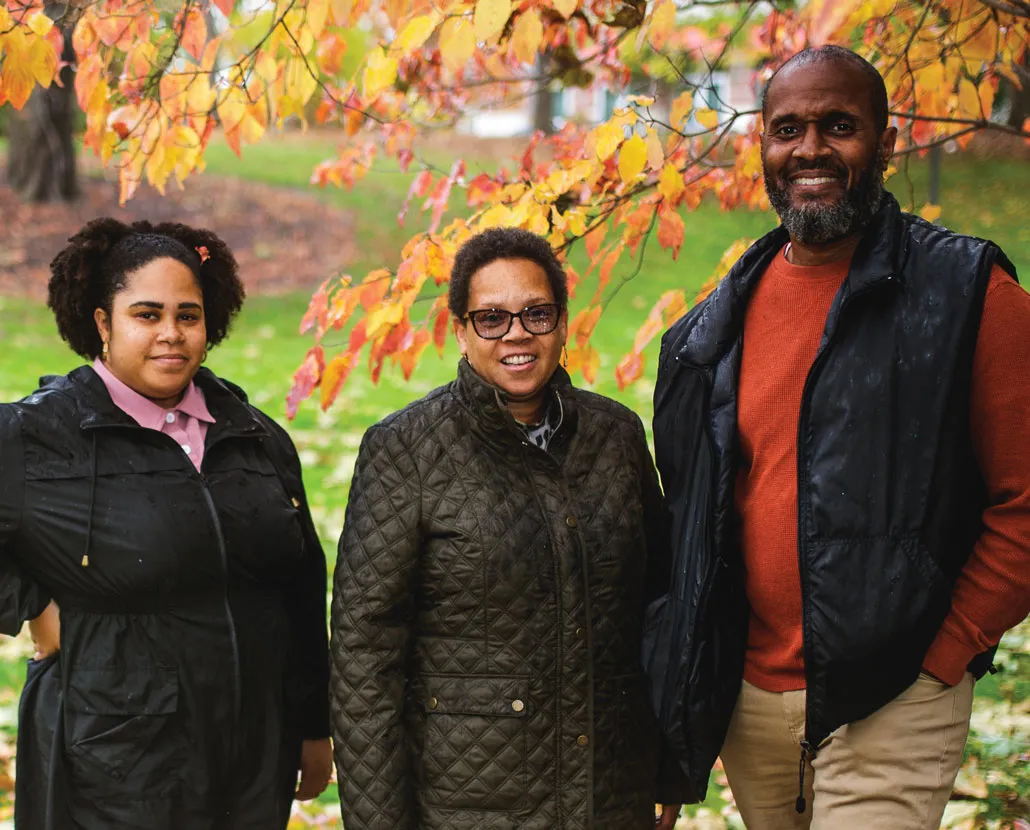
The residents of Flint — a city with a majority Black population and many people experiencing poverty — know this disregard well. In April 2014, to cut costs, state officials switched the city’s water source from Lake Huron to the Flint River without an adequate treatment plan. The public health catastrophe that has followed “is a story of government failure, intransigence, unpreparedness, delay, inaction and environmental injustice,” according to the final report from the Flint Water Advisory Task Force, commissioned to find the causes of the water disaster. The human-made crisis turned a necessity into a hazard for the residents of the city, which had a population of around 99,000 at the time. The lack of proper treatment exposed people to bacteria, excessive disinfection chemicals and lead.
Residents reported that their physical health suffered. People broke out in rashes, lost hair and had gastrointestinal illnesses. Researchers found an association between a local, deadly Legionnaires’ disease outbreak in 2014–15 and insufficient disinfection in the water system. Many children have developed health and behavioral problems from lead poisoning. “I am so upset,” says Bishop Bernadel Jefferson of Faith Deliverance Center in Flint, speaking of her grandson’s lead exposure and subsequent learning difficulties. “The system failed him.”
Mental health has suffered, too. Residents have reported experiencing depression, anxiety and post-traumatic stress disorder. With disasters, especially those that involve toxic exposures, “the emotional consequences are long-term, because they’re fueled by this concern [that] health or cognitive functioning has been forever adversely affected,” says Evelyn Bromet, a psychiatric epidemiologist at the Renaissance School of Medicine at Stony Brook University in New York who has studied the Chernobyl nuclear power plant disaster.
For a year and a half, officials dismissed residents’ concerns about the safety of the water. “It was horrifying, because not only were they not believed, but they weren’t taken seriously,” Bromet says. The anger that goes along with that “is of course a detrimental emotional state to be in for a long period of time.”
Other difficult experiences compounded the anguish that came with the water disaster. “This community has been exposed to multiple traumas,” says Womack, a social worker at the University of Michigan–Flint. When the disaster began, Flint was still struggling with the loss of tens of thousands of jobs due to General Motors’ layoffs and plant closures from the 1970s to the 1990s. The COVID-19 pandemic began as the water disaster continued.
Mental health remains a pressing concern for the community. But there aren’t enough mental health providers to meet the need, says Barbara Wolf, a clinical health psychologist at McLaren Health Care in Flint. Genesee County, which includes Flint, is among the areas in the United States with a shortage of mental health professionals, according to the U.S. Department of Health and Human Services.

So, as they’ve done before, Flint residents are finding a way. It was the community’s organizing and activism that brought attention to the water disaster. And as Flint approaches 10 years since the disaster began, local organizations continue to help the community heal. There are mental health and resiliency trainings, mindfulness meditation and community conversations about mental health. “There’s not just one approach,” says Kristin Stevenson, project manager for the Flint Resiliency in Communities After Stress and Trauma, or ReCAST, program at the Greater Flint Health Coalition, and a healing practitioner. “All of these things combined are what create the impact.”
What has happened in Flint — and what continues there — illustrates a community’s activism and perseverance, as well as the mental health fallout of a disaster. But this story won’t end in Flint. Communities across the country could find themselves part of the next chapter, their lives upended by catastrophe. The United States’ aging water infrastructure has led to other water crises and could trigger more. Wildfires, hurricanes and floods, fueled by climate change and other human-caused environmental changes, are increasing in frequency and destructiveness. Mental health will suffer in the aftermath of these traumatic events. The water disaster in Flint can be seen as both a warning and a model of community response.
“We recognize that our struggle, if not now, will become yours,” Womack says.
The making of the water disaster in Flint
A decorative archway spanning one of downtown Flint’s main thoroughfares reads “Flint: Vehicle City.” The city was home to a booming carriage business before General Motors was founded there in 1908. Residents look back with pride on the community’s activism during GM workers’ famous sit-down strike for better pay and recognition of their union, the United Auto Workers. For around six weeks in 1936–37, striking workers occupied factories to stop production. Family and community members provided supplies and support from the outside. The strike heralded the rise of the labor movement in the automotive industry.

As in other cities, Flint’s industrial growth was detrimental to its river, as factories would discharge waste directly into the water. The Clean Water Act of 1972, which regulates pollution from industrial and municipal sources, has improved the health of U.S. waterways, including Flint’s. In 1974, the Safe Drinking Water Act was enacted to safeguard the country’s drinking water. The law sets standards for levels of contaminants, including microorganisms, chemicals and metals such as lead.
In 2014, Flint’s water treatment plant hadn’t been fully operational for almost 50 years. Instead, the city had been purchasing treated Lake Huron water from Detroit’s water utility. But an unelected emergency manager, placed in charge of Flint’s finances by Michigan’s then-Governor Rick Snyder, had authorized a switch to the Flint River as a cost-saving measure. Water treatment is a complex process, and the Flint River water was more corrosive than other water sources. But the Flint plant didn’t test its treatment procedures sufficiently, according to an analysis by water treatment experts. In violation of federal requirements, there was no corrosion control treatment, which helps prevent lead from leaching into the water as it moves through the distribution system’s pipes.
When residents turned on their faucets in the weeks after the switch on April 25, they were unsettled by what came out. “I used to love tap water, just to run it and let it get cold,” Jefferson says. But after the switch, the water left a film in her mouth. Flint resident Gina Luster liked to chew ice, but it started to taste “like metal, like I’m chewing steel.” Cynthia Watkins, apostle at the Well International Church Ministries in Flint, remembers the water “just smelling, it was horrible.” For Roshanda Womack, a professional storyteller and spouse of Todd Womack, the water had a strong odor and was sometimes cloudy or had a slight brown tinge to it.
People in the community spoke out about the poor water quality, with some reporting rashes from exposure to the water. But officials maintained that the water was safe for use.
Warning signs mounted in the following months. The water in the distribution system tested positive in August for E. coli, which can indicate fecal contamination and inadequate disinfection. This prompted a boil water advisory. In October, General Motors announced that it would stop using the city’s water at an engine plant over concerns about corrosion. While the company switched to a different water supply for manufacturing, officials still claimed Flint’s water met safety standards for people. Throughout 2014, church leaders and other community members worked to elevate people’s concerns about the water.
At the end of 2014, the city was served with a Safe Drinking Water Act violation, having exceeded allowable levels of trihalomethanes, disinfection by-products tied to an increased risk of cancer. These chemicals form when disinfectant added during treatment reacts with naturally occurring materials in river and lake water. One of the challenges of water treatment is maintaining proper disinfection while limiting by-product chemicals.
After the public notice of the violation in January 2015, Flint resident LeeAnne Walters asked the city to test her water. Samples from February and March revealed lead levels around seven and 27 times what spurs regulatory action. Walters’ home plumbing was plastic. An analysis of the city service line to the house revealed it was the source of the lead. When Walters’ 4-year-old son was tested for lead in March, his level was 6.5 micrograms per deciliter. No amount of lead is considered safe. At the time, the U.S. Centers for Disease Control and Prevention used a reference value of 5 µg/dL, developed based on national surveys, to identify kids with the highest lead levels. In 2021, the CDC lowered that reference value to 3.5 µg/dL.
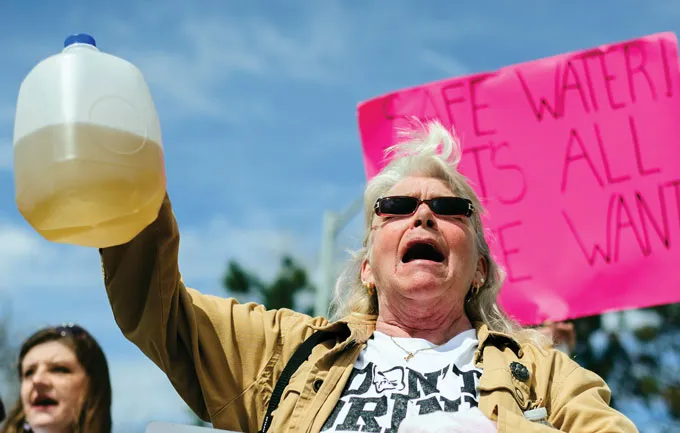
As the year continued, local organizations and churches formed the Coalition for Clean Water, which passed out flyers to inform residents of the water safety issues and collected water samples for testing. People protested, with rallies in Flint, Detroit and Lansing, the state capital. In August, organizers delivered to the mayor a petition, with more than 26,000 signatures, demanding to switch back to water from the Detroit system.
Then, at a September news conference, local researchers announced an alarming rise in the percentage of Flint children with lead levels of 5 µg/dL or higher. The analysis included children younger than age 5 who had had their levels checked as part of routine lead screening — 736 children in 2013, before the water source changed, and 737 after, in 2015. The percentage of kids considered to have high lead levels increased from 2.4 percent in 2013 to 4.9 percent in 2015, the researchers reported in 2016 in the American Journal of Public Health. In neighborhoods with the most lead in the water, the jump was from 4.0 to 10.6 percent. A similar change was not seen in 2,202 children who lived outside of the city and had a different water source.
Lead harms children’s developing brains and nervous systems. Studies have found that the metal disrupts communication between nerve cells and impairs the hippocampus, a brain region important in learning and memory. Children exposed to lead can develop learning disabilities, speech and hearing disorders, and behavioral problems. The damage can shape the rest of their lives.
Officials ultimately couldn’t brush aside the evidence of poisoned children. The city reconnected to the Detroit water system on October 16, 2015. But that water still had to flow through Flint’s pipes, which had become corroded. The city has been replacing its lead service lines but has repeatedly missed court-ordered deadlines and still isn’t finished. Lead levels have been in compliance with federal regulations since 2016 but have fluctuated recently. In 2022, lead levels rose to the highest seen in six years.
“We’re still not fixed,” says Kent Key, a health disparities researcher at the Flint campus of Michigan State University’s College of Human Medicine.
The Flint Water Advisory Task Force reported that the state government was primarily responsible for the water disaster.
The anguish Flint residents have felt
The Flint community organized, rallied and distributed testing kits and bottled water while people there lived through a disaster. “The water disaster was a traumatic experience,” Todd Womack says. “At the time, I don’t think people were saying it was traumatic. I think they were saying, ‘How do we get this basic need?’”
Eventually, the trauma rose to the surface. There had been so much worry, stress, anger and grief. Parents who had cajoled their kids to choose water over soda and juice were distraught. “I feel so guilty now,” Luster says. “I was poisoning my kid.” Pets died unexpectedly, which seemed to be tied to drinking the water. “I ended up losing both my dogs,” Watkins says. “That was just devastating.” Getting enough bottled water was a financial hardship for many. “I watched people, low-income families or on a fixed income … take half of their money to buy water every month,” Jefferson says.
And for so long, residents were told, “ ‘You’re paranoid, you’re crazy, the water is fine,’ ” Roshanda Womack says, “when you can see it’s not fine.” Jennifer Carrera, an environmental sociologist at Michigan State University in East Lansing, says there were “so many ways in which the treatment of the residents minimized their experiences…. Gaslighting is a very fair way of characterizing what happened to Flint residents.”
Yet General Motors got a different water supply for its plant. “For parts, for automobile parts,” Jefferson says, but not for people. “It was all right for us to be poisoned. It was all right to be sick. It was all right to die.”
Dionna Brown, a sociology graduate student at Wayne State University in Detroit, grew up in Flint and was a teenager during the water disaster. Brown felt “like the government is trying to poison a Black city.” She realized, “Black children, we can’t have a childhood. We have to grow up fast.”
“To live with that level of betrayal,” says Bromet, the Stony Brook psychiatric epidemiologist, “of course it takes its toll.”
As does the lack of justice. “The perpetrator, in a just and fair society, is held accountable,” Key says. “In the Flint water crisis, that still hasn’t happened.” The city has been “forced to work with the perpetrator, the state, to work towards recovery.”
The experience has left many unconvinced that the city’s water is safe. “I think you’re just going to have a large portion of the population that is never going to drink the water again,” says social epidemiologist Jerel Ezell of the University of California, Berkeley, who grew up in the Flint suburbs.
Worrying about water “puts a strain on you,” says Flint resident Tyshae Brady. “I don’t want to always go over to a friend’s house and go, ‘Hey, is your water safe to drink?’ ” The unease extends beyond Flint, too. Flint church elder Sarah Bailey, who has worked on stroke prevention in the community and other projects, recalls being at a Boston restaurant with colleagues. “The waitress brings some water to the table in glasses, and I reach over and say, ‘Do you happen to have any bottled water?’ ” One of her colleagues told Bailey the water was safe. “I said, ‘For you…. The water was not safe for me.’ ”

The mental health aftermath of the water crisis
The disaster has weighed heavily on the mental health of residents, both children and adults. From December 2018 to March 2020, researchers surveyed the caregivers of 1,203 children, ages 3 to 17. The caregiver-reported rates of anxiety and depression among the children were 13 percent for anxiety and 8 percent for depression, higher than the national rates of 9 and 4 percent for that age group, the researchers reported in September in the American Journal of Public Health.
A different research team surveyed 1,970 adult residents from August 2019 to April 2020 — around that time, Flint’s total population was just over 81,000. Twenty-two percent of the respondents had experienced symptoms of depression in the past year, while 24 percent met criteria for post-traumatic stress disorder. That’s higher than the estimated past-year rates, 8 percent for depression and 5 percent for PTSD, for the U.S. population. Extending the findings to Flint’s population suggests that around 13,600 adults may have experienced depression and around 15,000 may have had PTSD, the researchers reported in 2022 in JAMA Network Open.
People who were worried the water had harmed their or their family’s health were more than twice as likely to meet the criteria for depression and about 1.7 times as likely for PTSD, compared with people without this concern.
Past tragedies, such as a serious accident, physical abuse, sexual assault or a previous environmental calamity, can increase mental health risks when disaster strikes. “Your cumulative exposure to potentially traumatic events drives a lot of the risk for either developing or maintaining PTSD or depression,” says Dean Kilpatrick, a clinical psychologist at the Medical University of South Carolina in Charleston and one of the authors of the study in adults. Kilpatrick and colleagues found that the risk of developing symptoms of depression increased by a factor of close to three, and for PTSD symptoms by a factor of 4.6, for Flint residents with past exposure to a potentially traumatic event, compared with those without.
For some, mental health issues from disasters may persist for years. Researchers followed mothers who experienced Hurricane Katrina and had incomes less than twice the federal poverty line. The women were surveyed at three points after August of 2005, when the storm hit the U.S. Gulf Coast. Although rates of post-traumatic stress symptoms declined over time among the women, 1 in 6 still had symptoms 12 years after the hurricane, researchers reported in 2019 in Social Science & Medicine. Mothers with young children who were evacuees after the Chernobyl disaster and Chernobyl cleanup workers have had long-lasting mental health consequences.
Despite the potential impacts, only 35 percent of respondents in the study in JAMA Network Open reported that they had ever been offered mental health care to attend to issues that arose from the water disaster. If offered, most people — 79 percent — took advantage.
The COVID-19 pandemic, another traumatic experience, hit the community while they were still dealing with the water disaster. In the most recent Community Health Needs Assessment for Flint and surrounding Genesee County, from 2022, 45 percent of respondents to the assessment’s resident survey indicated that they were dealing with stress, and 33 percent said they had mental health problems such as depression or anxiety.
How the community is helping and healing
Having too few mental health care practitioners is not an issue unique to Flint. Nearly 166 million people in the United States, about half the population, live in areas with a shortage of mental health professionals. The COVID-19 pandemic has only exacerbated the problem.
Treatment options did recently expand somewhat in Flint. In May, local mental health services provider Genesee Health System opened a new outpatient clinic that serves uninsured county residents. The treatment facility is funded in part by a recently passed property tax increase to support mental health in the county.
Beyond that, Flint organizations are taking community-based approaches to help residents cope. The Flint ReCAST program, supported with a grant from the federal Substance Abuse and Mental Health Services Administration, funds local organizations seeking to address trauma and stress in the community. ReCAST has supported art, music and dance programs for young people and an initiative to build mindfulness skills among the police and community members.
ReCAST also funds Genesee Health System to offer free community mental health and resiliency trainings, on topics ranging from recognizing suicidal ideation to learning about mental health and stigma to building resiliency. ReCAST and Genesee mental health professionals have teamed up for virtual conversations about mental health called Talk About It Tuesdays.
The Flint Public Health Youth Academy, which Key began developing in 2014, is a homegrown initiative to inspire Flint’s young people to pursue careers in public health. “I wanted to create a youth group that did not allow the water crisis to be a sentence of doom and gloom,” he says, but rather a jumping-off point to create the next generation of public health professionals. Among the academy’s activities is an annual summer camp that centers on a public health topic, such as environmental justice.
Looking to the future, Stevenson, the project manager for ReCAST, is interested in bringing training of mental health ambassadors to Flint. The idea is to train trusted community members to be a source of mental health information for their neighborhoods. Stevenson is also a big proponent of healing circles as a way to help people heal and build resilience.
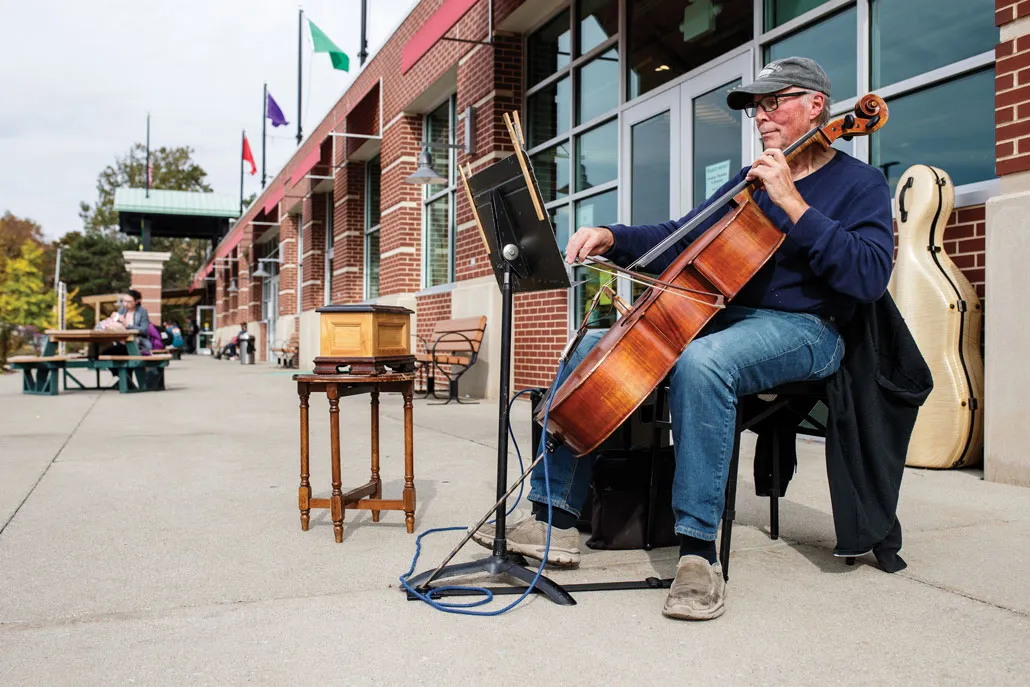
At the close of one healing circle on that Saturday in May, Todd Womack took out a skein of moss green yarn. Womack asked the participants to be ready to share something they appreciate about themselves. Womack went first, then tossed the skein to another participant while holding on to a piece of the yarn. As each person took a turn, the skein zigzagged across the space, unwinding along the way. In the end, everyone in the circle was holding on to the web of yarn, a physical reminder of the community and connections created that morning.
That afternoon, three different groups formed to discuss changes residents would like to see in Flint. People responded on sticky notes to different questions, such as what Flint would look like without gun violence. People talked about the city’s history, GM’s layoffs and the abandoned homes that still dot many neighborhoods, the result of years of population loss. After a peak of nearly 197,000 in 1960, the latest population estimate, from 2022, is under 80,000.
The people gathered that Saturday are among those who have stayed. They are Flintstones, as residents call themselves. While brainstorming about Flint’s future, playful chants broke out between the groups, each of which had taken on a Flint-related name. “Flintstones!” one group cried. “810!” another responded, referring to the local area code. “Bedrock!” boomed the third, naming the town from the old The Flintstones cartoon.
When residents reflect on Flint, the strong sense of community comes up again and again. It’s how residents have stood up for their health and safety during a disaster, and it’s how they continue to care for each other.
“There’s really this unity and connectedness with anyone who has lived here,” Todd Womack says.
“We’re a loving city,” Dionna Brown says, “and we’re going to be OK.”
“There are amazing, deeply committed people that live here … there’s a lot of commitment, there’s a lot of passion,” Lynn Williams says. “And that’s why we stay.”
